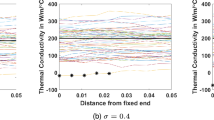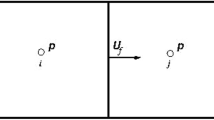Abstract
FEA-based Gaussian density heat source models were developed to study the effect of convective and radiative heat sinks on the transient temperature field predicted by the available analytical solution of the purely conduction-based Goldak’s heat source. A new complex 3D Gaussian heat source model, incorporating all three modes of heat transfer, i.e. conduction, convection and radiation, has been developed as an extension of the Goldak heat source. The approximate transient analytical solutions for this 3D moving heat source were derived and numerically benchmarked with the available measured temperature and weld pool geometry data. The calibrated transient temperature field generated by MATLAB programming was 5 to 6 times faster than by FEA-based simulation. The new complex 3D Gaussian heat source model and its approximate solution could significantly reduce the computing time in generating the transient temperature field and be an efficient alternative to extensive FEA-based simulations of heating sequences, where virtual optimisation of a melting heat source (i.e. used in welding, heating, cutting or other advanced manufacturing processes) is desirable for characterisation of material behaviour in microstructure evolution, melted pool, microhardness, residual stress and distortions.














Similar content being viewed by others
Availability of data and material
Measured transient temperature data and weld bead geometry of Nguyen et al.’s bead-on-plate data [Ref. 5] used to benchmark the Gaussian heat source are available upon request.
Code availability
The input file and Dflux user subroutines used for Abaqus FEA modelling; MATLAB codes for implementing the approximate analytical solutions for the complex Gaussian heat source developed in this work, i.e. simulating the transient temperature field for a bead-on-plate subjected to this heat source, are available upon request.
References
Rosenthal D 1941. Mathematical theory of heat distribution during welding and cutting, Welding Journal Weld. Res. Suppl. 20(5): 220-s to 234-s
Carslaw HS, Jaeger JC (1959) Conduction of heat in solids. Oxford University Press, Cambridge, UK
Eager TW, and Tsai NS 1983. Temperature fields produced by traveling distributed heat sources. Welding Journal Weld. Res. Suppl. 62(12): 346-s to 355-s.
Goldak, J., Chakravarti, A., and Bibby, M. 1985. “A double ellipsoid finite element model for welding heat sources”, IIW Doc. No. 212-603-85.
Nguyen N. T, Ohta A. et al. 1999, “Analytical solution for transient temperature of semi-infinite body subjected to 3-D moving heat sources”, Welding Journal, Weld. Res. Suppl. August 1999, Vol. 78(8): 265-s to 274-s.
Nguyen NT et al (2004) “Analytical approximate solution for double ellipsoidal heat source in finite thick plate”, Welding Journal, Weld. Res. Suppl. April 2004, Vol. 83(3): 82-s to 89-s.
K. Guo and S. Dai, “Analytical solution to transient temperature field based on coefficient of thermal conductivity”, Welding Journal, Weld. Res. Suppl. April 2017, Vol. 96(4): 113-s to 120-s.
Wenji L, Liangyu L, Jianfeng Y, Haihua L, Lei Y (2015) A kind of analytical of arc welding temperature distribution under material properties. Int J Adv Manuf Technol 81:1109–1116
R. Goyal, E. Johnson, M El-Zein, J. Goldak, M. Coulombe and S. Tchernov (2009) “A model equation for the convection coefficient for thermal analysis of welded structures”, Trends in Welding Research, Proceedings of the 8th International Conference, Stan A. David, Tarasankar DebRoy, John N. DuPont, Toshihiko Koseki, Herschel B. Smartt, editors, p 321-327, ASM International
C. S. Pathak, L. G. Navale, A. D. Sahasrabudhe and M. J Rathod (2012) “Analysis of thermal cycles during multipass arc welding”, Welding Journal, Weld. Res. Supplement, May, Vol. 91, 149s-154s
Ryszard P, Jerzy W (2013) “Analytical solution of temporary temperature field in half-infinite body caused by moving tilted volumetric heat source” Int J Heat Mass Transf 60:469–479
Veldman DWM, Fey RHB, Zwart HJ, van de Wal MMJ, van den Boom JDDJ, Nijmeijer H (2018) Semi-analytical approximation of the temperature field resulting from moving heat loads. Int J Heat Mass Transf 122:128–137
Barbaros Cetin YF Kuscu Baris Cetin, O Tumuklu and KD Cole(2020) “Semi-analytical source (SAS) method for 3-D transient heat conduction problems with moving heat source of arbitrary shape”, Int. Journal of Mass and Heat Transfer, Nov. 25, pp. 1-11. Elsevier, ScienceDirect
Volker Kempf (2019) “Approximated analytical approach for temperature calculation in pulsed arc welding”, Inter. Journal on Interactive Design and Manufacturing (IJDeM), ISSN 1955-2513 https://doi.org/10.1007/s12008-019-00638-8, Springer Online, Published on 01 November
NV Dhandapani, V Dhinakaran, K Krisnakumar and V Rajkumar (2020) “Transient thermal finite element simulation of moving gas tungsten arc welding on AISI 4340 aeronautical steel”, AIP Conference Proceedings 2283, 020108(2020); https://doi.org/10.1063/5.0025111, Published Online: 29 October
Magalhaes ES, Fernandez AL and Marcondes SM (2017) “A GTA welding cooling rate analysis on stainless steel and aluminium using Inverse problems”, Applied Sciences, www.mpdi.com/journal/applsci, Applied Science, Vol. 7, No. 122: doi:10.3390/app7020122, pp. 1-15.
Bayat M, Thanki A, Mohanty A, Witvrouw A, Yang S, Thorborg J, Tiedje NS and Hattel JH (2019) “Keyhole-induced porosities in laser-based powder bed fusion (L-PBF) of Ti6Al4V: high-fidelity modelling and experimental validation”, Elsevier, Additive Manufacturing 30 100835, pp.1-17
X. Song, S Feih, W Zhai, C.N Sun, F. Li, R. Maiti, J. Wei, Y. Yang, V. Oancea, L R. Brandt and A M Korsunsky (2020) “Advances in additive manufacturing process simulation: residual stresses and distortion predictions in complex metallic components”, Elsevier, Materials and Designs 193 108779, pp. 1-14
Zhang Q, Xie J, Gao Z, London T, Griffiths D, Oancea V (2019) A metallurgical phase transformation framework applied to SLM additive manufacturing processes. Mater Des 166:107618
Cook PS, Murphy AB (2020) Review: Simulation of melt pool behaviour during additive manufacturing: underlying physics and progress. Additive Manufacturing 31(2020):100909
Wang H, Wang L, Cui R, Wang B, Lua L, Su Y (2020) Difference in microstructure and nano-hardness of selective laser melted Inconel 718 single tracks under various melting modes of molten pool. J of Material Research and Technology 9(5):10401–10410
Kokko R, Vaara J, Kuivaniemi T, Frondelius T (2020) Numerical simulation of laser welded joints: modern fatigue analysis methodology. Rakenteiden Mekaniikka (Journal of Structural Mechanics) 53(4):342–355
Van Elsen M, Baelmans M, Mercelis P, Kruth JP (2007) Solutions for modelling moving heat sources in a semi-infinite medium and applications to laser material processing. Int J Heat Mass Transf 50(23-24):4872–4882
J. Dutta, S. Narendranath(2014) “experimental and analytical investigation of thermal parameters developed in high carbon steel joints formed by GTA welding”, Journal of Mechanical Engineering, Vol. ME 44, No. 2
Lemkeddem S, Khelfaoui F, Badahani O (2018) Calculation of energy lost by radiation and convection welding of TA6V titanium alloy. Journal of Theoretical and Applied Physics 12:113–120
Deng D (2009) FEM prediction of welding residual stress and distortion in carbon steel considering phase transformation effects. Mater Des 30:359–366
Murugan N, Parmar RS (1994) Effects of MIG process parameters on the geometry of the bead in the automatic surfacing of stainless steel. J Mater Process Technol 41(4):381–398
Towsyfyan H, Gholamreza D, Heidarian DB, Kariminasab A (2013) Comparing the regression analysis and artificial neural network in modeling the SAW (SAW) process. Res J Appl Sci Eng Technol 5(9):2701–2706
Fu G, Lourenço MI, Duan M, Estefen SF (2016) Influence of the welding sequence on residual stress and distortion of fillet welded structures. Mar Struct 46:30–55
Chujutalli JH, Lourenço MI, Estefen SF (2020) Experimental-based methodology for the double ellipsoidal heat source parameters in welding simulations. Marine Systems & Ocean Technology 15:110–123
Hibbit, Karlsson and Sorensen, Abaqus (2013) User’s and Theory Manuals Version 6.12, Hibbit, Karlsson and Sorensen, Inc, Providence, RI
Radaj D (1992) Heat effects of welding – temperature field, residual stress, distortion. Springer-Verlag, Berlin
The Welder, “Understanding transfer mode for GMAW, The web source: https://www.thefabricator.com/thewelder/article/consumables/understanding-transfer-modes-for-gmaw
ANSYS (2020) user manual ,pdf version, www.Ansys.com
Acknowledgements
Contribution of Mohammad Nasiri in earlier stage of this project for initial MATLAB codes implementing the heat convection effect was greatly appreciated. This project was purely volunteer research project, based on the tremendous efforts and endless time of the authors who have strong common interest and passion for advancing research in Gaussian heat sources, FEA-based simulation and its transient analytical solutions for potential industrial applications.
Funding
The second author gratefully acknowledges the financial support from the National Agency for Petroleum, Natural Gas and Biofuels (ANP)-PRH 18 and FINEP for the fellowship, not directly related to this project as he worked on this project voluntarily in addition to his work’s project.
Author information
Authors and Affiliations
Contributions
The first author has derived the new complex Gaussian heat source by extending the Goldak’s heat source to include all three modes of heat transfer (i.e. conduction, convection and radiation); derivation of approximate analytical solutions and give direction to Abaqus-based finite element modelling; and carried out MATLAB implementation of the analytical solutions for transient temperature field for bead-on-plate and manuscript.
The second author has carried out the Abaqus-based FEA modelling of the complex Gaussian heat source, heat source calibration, sensitivity study and manuscript.
Corresponding author
Ethics declarations
Ethics approval
‘Not applicable’.
Consent to participate
‘Not applicable’.
Consent for publication
We give our consent for publication of this work in JAMT after the panel review approval.
Conflict of interest
The authors declare no competing interests.
Additional information
Publisher’s note
Springer Nature remains neutral with regard to jurisdictional claims in published maps and institutional affiliations.
Appendix. Analytical solution of the complex heat source by MATLAB codes
Appendix. Analytical solution of the complex heat source by MATLAB codes
Figure 15 shows a captured screen of the MATLAB code run display at the end of the path 2 of the bead-on-plate GMAW simulation. The temperature contour surrounding the heat source is shown on the steel plate cross-section, cutting through the centre planes of the weld paths.
There are four small windows designated for the real-time display of the weld pool shapes, i.e. showing the real time sizes of the weld pool length, with and depth with constant iso-boundary temperature depicted at 1370°C.
The top two windows (left and right) showing the weld pool boundary due to heat conduction-only transient temperature solution for the Goldak’s heat source by Nguyen et al. [5], using calibrated heat source parameters. The bottom two windows (left and right) showing the effective weld pool shape geometry (i.e. pool length, width and depth), determined from the approximate analytical transient solution for the complex heat source which incorporated all three modes of heat transfer, i.e. heat conduction, convection and radiation.
The approximate transient analytical solution of the complex heat source model was implemented by written MATLAB codes, with calibrated Goldak’s heat source parameter [chf, chb ah bh ] = [10 20 10 1.5], typical heat convection film in quiet air h = 5 W/m2/°C, grey body of steel plate with emissivity of 0.67 and radiative correction factor of krad = 0.02 for temperature solution reduction, due to radiative heat sink as per the approximate analytical solution for the complex heat source equations, developed in this work.
The transient temperature depicted at three selected points A, B and C and its corresponding temperature reductions due to convective and radiative heat sinks are shown in Fig. 16a and 16b, respectively.
Figure 17 shows the calibrated transient temperatures, generated by Matlab codes for the point A, B and C, are compared reasonable well with the transient temperature data from Nguyen’s et al experiment [5]. The plot has demonstrated the validity of the approximate transient analytical solution of the complex heat source model that could be used as an efficient alternative for extensive FEA-based simulations of heating sequences, where virtual optimisation of a melting heat source (i.e. used in welding, heating, cutting or other advanced manufacturing processes) is desirable.
Transient temperature by MATLAB codes was benchmarked with the measured temperature data [5] to obtain suitable heat source parameters for the complex heat source analytical solution
Rights and permissions
About this article
Cite this article
Nguyen, N., Chujutalli, J.H. Simulating convective-radiative heat sink effect by means of FEA-based Gaussian heat sources and its approximate analytical solutions for semi-infinite body. Int J Adv Manuf Technol 117, 3717–3742 (2021). https://doi.org/10.1007/s00170-021-07699-8
Received:
Accepted:
Published:
Issue Date:
DOI: https://doi.org/10.1007/s00170-021-07699-8







